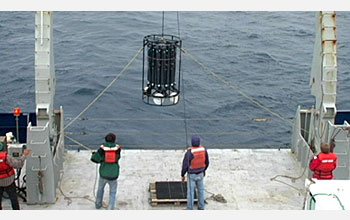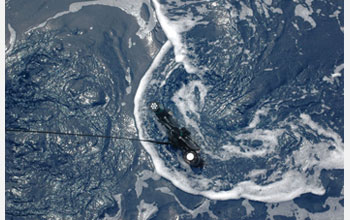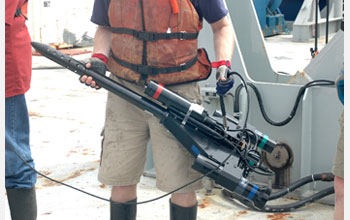|

All Images

Discovery
Mysterious Compound Seen as Key to Ocean Life

Back to article | Note about images
 |
Bill Hiscock and Maxime Grand, both of the University of Hawaii, use taglines to control the sway of the CTD (Conductivity, Temperature, Depth recorder) rosette as it enters the water. The rosette is a system of specialized bottles attached to a metal framework that travels deep into the water column to gather samples. When the rosette and the accompanying sensors are removed from the water, the package will hold twelve 10-liter (2.6 gallon) bottles of seawater and weigh a total of about 816 kilograms (1800 pounds).
Credit: Daniel Park |
Download the high-resolution JPG version of the image. (53 KB)
|
Use your mouse to right-click (or Ctrl-click on a Mac) the link above and choose the option that will save the file or target to your computer.
|
 |
The hand-held profiler principally contains light sensors, a fluorometer to measure chlorophyll in plants and a sensor to measure turbidity--the amount of tiny debris particles floating in the water. The CLIVAR cruise researchers deploy the instrument from the stern, or back end of the ship. The ship slows down so that the crew can carefully lower the profiler into the water.
Credit: Cassandra Lopez, Rosenstiel School of Marine and Atmospheric Science, University of Miami |
Download the high-resolution JPG version of the image. (104 KB)
|
Use your mouse to right-click (or Ctrl-click on a Mac) the link above and choose the option that will save the file or target to your computer.
|
 |
Norm Nelson shows the hand-held profiler. The profiler consists of several instruments that are used to measure light, radiance, chlorophyll and turbidity. With the data gathered from the profiler, scientists measure levels of chromophoric dissolved organic matter, or CDOM.
Credit: Cassandra Lopez, Rosenstiel School of Marine and Atmospheric Science, University of Miami |
Download the high-resolution JPG version of the image. (1.7 MB)
|
Use your mouse to right-click (or Ctrl-click on a Mac) the link above and choose the option that will save the file or target to your computer.
|
|





